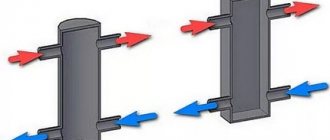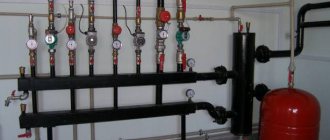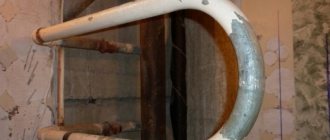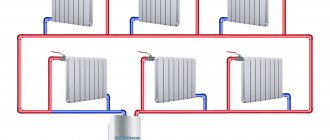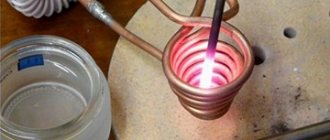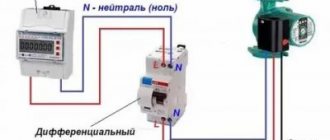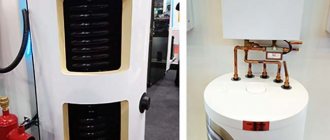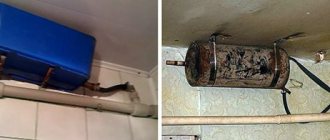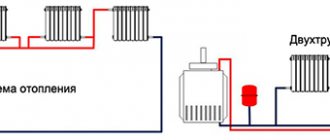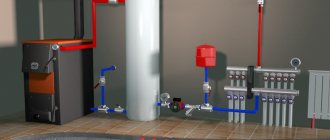Hydrostrelka: principle of operation, purpose and calculations
The heat supply system of an individual home may consist of several subsystems.
The implementation of each branch must be carried out independently of the pressure and coolant flow of each function. Due to the fact that the coolant comes from one point, this leads to an imbalance in the individual circuits of the system. To prevent such a situation from arising, hydraulic arrows (anuloids) are installed in the heat supply system.
Main functions
When organizing heat supply from a boiler using solid fuels, water flows are heated by a boiler, the resistance of which is an order of magnitude lower than in the main system.
The heating system often includes underfloor heating, bathrooms and a kitchen. That is, at least three consumers are connected to one heat generator. The temperature regime of each is individually adjusted, and, accordingly, has a different heating isolation resistance. In order to avoid imbalance of the heating system, they must be combined.
This is precisely the basic principle of operation of the hydraulic arrow. In other words, it divides the heat supply system into two autonomous circuits: the heat generator and the general heating of the house, which includes all subsystems.
The decoupling of subsystems in the overall system is arranged according to the same principle; they do not affect each other. Thus, the hydraulic needle solves the issue of balancing boiler equipment and the heat supply system.
It is recommended to use a separator when, without its use, the pressure difference between the supply and return exceeds four hundredths of a meter of water column. Inside the anuloid, hot and cooled water are exchanged.
The separator operates in one of 3 modes:
- the flows of both circuits are equal. Operation with correctly selected pumps occurs only if all pumps of the boiler equipment and heating system operate simultaneously in normal mode;
- the flow of the primary circuit is significantly less than the second. Implementation is possible only in cases where it is sufficient to operate only one boiler from the entire heating system.
- the flow of the second circuit is significantly less than the first. Implementation is possible when the heat supply is suspended or only one zone is required to be heated.
Thanks to the operation of the hydraulic switch, it is possible to regulate the boiler equipment and heating system of the entire house. Therefore, it is not worth saving on its purchase and installation.
Hydraulic gun operating modes
Additional functions
In addition to protecting the heat exchanger from thermal shock, the hydraulic arrow protects the heating system from damage in the event of an emergency shutdown of the home’s water supply system, floor heating and other subsystems.
In addition, it acts as a sump for mechanical formations such as scale and rust. Another important function for which a hydraulic arrow is needed in a heating system is the elimination of air masses from the coolant.
Operating principle of hydraulic separator
Two physical processes from two branches of physics take place in a hydraulic separator. Hydraulics helps to understand how water moves in the separator, and thermal engineering helps to understand how cold and hot flows mix in the separator.
Let's start with hydraulics. We have two coolant flow circuits. Circuit K1 (heating boiler circuit) and circuit K2 (heating system circuit) to ensure the movement of coolant, a circulation pump is installed in each circuit. It is customary to install pumps on cold branches of circuits. Although installing pumps on hot branches increases the speed of movement of the coolant due to the low viscosity of the hot liquid.
So, two dynamically independent flows of circuits K1 and K2 move in the hydraulic arrow. The speed of movement of these flows should not exceed 0.1 m/sec. Let me explain why.
A low coolant flow rate in the hydraulic separator is needed for four reasons:
- At low fluid speeds, sand, sludge and other water debris settle in the separator.
- At low speed, the cold coolant moves down and the hot coolant rises. This natural circulation allows the creation of temperature gradients in heating loops. It is possible to obtain a heating circuit with an increased or decreased temperature. Typically, a lower temperature is created by a separator in a heated floor system, and an increased temperature in an indirect heating circuit with a boiler.
- You can make a mixing unit from a hydraulic arrow. This is useful if the house has one heating circuit. By reducing the diameter of the separator, you will increase the speed of water movement and the temperatures of both loops (boiler and heating) will be equalized. This significantly saves material and reduces costs.
- The low speed of water in the separator removes air from the water, which is not needed in the heating system. The air is discharged through an automatic vent.
Subtotal
A hydraulic separator allows you to separate two coolant circuits of different flow rates. The circulation pumps in both circuits and the diameter of the separator are selected such that the speed of the coolant in the separator does not exceed 0.1 m/sec.
Creating parts from polypropylene: features
Boiler parts made of polypropylene can operate at temperatures no higher than 175 degrees. That is why you don’t have to worry that the elements will suffer. You can install a plastic hydraulic arrow.
Polypropylene parts withstand high temperatures well
Advantages of installing a hydraulic arrow made of polypropylene:
- Thanks to the smooth walls of the structure, the coolant moves as smoothly as possible. And if the boiler has low power, then rapid movement reduces heat loss.
- Polypropylene can be painted in any color.
- Cheaper option than metal counterparts.
- Resistant to corrosion and deterioration.
- Can work with low power boilers.
But polypropylene hydraulic arrows also have disadvantages. Such products cannot be used for solid fuel boilers. The higher the power of the heating equipment, the less the hydraulic collector will last. Due to high pressure, parts wear out quickly. Installation of the device requires the use of special tools. The quality of the hydraulic connection determines the further operation of the device.
What capabilities are attributed to the hydraulic separator?
Among heating engineers, there are diametrically opposed opinions regarding the need to install hydraulic switches in heating systems. Adding fuel to the fire are statements from manufacturers of hydraulic equipment, promising increased flexibility in setting operating modes, increased efficiency and heat transfer efficiency. To separate the wheat from the chaff, let's first look at the completely baseless claims about the "outstanding" capabilities of hydraulic separators.
The efficiency of the boiler installation does not depend in any way on the devices installed after the boiler connecting pipes. The beneficial effect of the boiler lies entirely in its conversion ability, that is, in the percentage of heat generated by the generator to the heat absorbed by the coolant. No special piping methods can increase efficiency; it depends only on the surface area of the heat exchanger and the correct choice of coolant circulation rate.
Multi-mode, which is supposedly ensured by installing a hydraulic gun, is also an absolute myth.
The essence of the promises boils down to the fact that if you have a hydraulic switch, you can implement three options for flow ratios in the generator and consumer parts.
The first is absolute equalization of flow, which in practice is only possible if there is no shunting and there is only one circuit in the system. The second option, in which the flow rate in the circuits is greater than through the boiler, supposedly provides increased savings, but in this mode, supercooled coolant inevitably flows through the return to the heat exchanger, which gives rise to a number of negative effects: fogging of the internal surfaces of the combustion chamber or temperature shock.
There are also a number of arguments, each of which represents an incoherent set of terms, but in essence does not reflect anything concrete. These include increasing hydrodynamic stability, increasing the service life of equipment, controlling temperature distribution and others like them.
You can also come across the statement that the hydraulic separator allows you to stabilize the balancing of the hydraulic system, which in practice turns out to be exactly the opposite. If in the absence of a hydraulic switch the system’s reaction to a change in the flow in any part of it is inevitable, then in the presence of a separator it is also completely unpredictable.
Real Application Area
However, the thermal hydraulic separator is far from a useless device. This is a hydraulic device and the principle of its operation is described in sufficient detail in specialized literature. The hydraulic arrow has a well-defined, albeit rather narrow, area of application.
The most important benefit of a hydraulic separator is the ability to coordinate the operation of several circulation pumps in the generator and consumer parts of the system. It often happens that circuits connected to a common collector unit are supplied with pumps whose performance differs by 2 or more times.
In this case, the most powerful pump creates a pressure difference so high that the intake of coolant by other circulation devices is impossible. Several decades ago, this problem was solved by so-called washering - artificially lowering the flow in consumer circuits by welding metal plates with different hole diameters into the pipe.
The hydraulic arrow bypasses the supply and return lines, due to which the vacuum and excess pressure in them are leveled.
The second special case is the excess productivity of the boiler in relation to the consumption of the distribution circuits. This situation is typical for systems in which a number of consumers do not work on a permanent basis. For example, an indirect heating boiler, a swimming pool heat exchanger and heating circuits of buildings that are heated only from time to time can be linked to the general hydraulics.
Installing a hydraulic valve in such systems allows you to maintain the rated power of the boiler and the circulation speed all the time, while the excess heated coolant flows back into the boiler. When an additional consumer is turned on, the difference in costs is reduced and the excess is no longer sent to the heat exchanger, but to an open circuit.
The hydraulic arrow can also serve as a collector for the generator part when coordinating the operation of two boilers, especially if their power differs significantly.
An additional effect from the operation of the water gun can be called protection of the boiler from temperature shock, but for this, the flow rate in the generator part must exceed the flow rate in the consumer network by at least 20%. The latter is achieved by installing pumps of appropriate capacity.
How to select parameters
The hydraulic separator is selected taking into account the maximum possible coolant flow rate. The fact is that at high speeds of liquid movement through the pipes, it begins to make noise. To avoid this effect, the maximum speed is assumed to be 0.2 m/s.
Parameters required for the hydraulic separator
By maximum coolant flow
How to calculate the diameter of a hydraulic arrow using this method, you need to know the maximum coolant flow that is possible in the circuit and the diameter of the pipes. You know the diameter of the pipes, which pipe you will use for wiring. We know the maximum flow (it is in the technical specifications), and the flow rate through the circuits depends on their volume and is determined when selecting circuit pumps. The flow rate for all circuits is added and compared with the power of the boiler pump. A large value is substituted into the formula to calculate the volume of the hydraulic needle.
Formula for calculating the diameter of a hydraulic separator for a heating system depending on the maximum coolant flow
Let's give an example. Let the maximum flow rate in the system be 7.6 cubic meters/hour. The permissible maximum speed is taken as standard - 0.2 m/s, the diameter of the pipes is 6.3 cm (2.5 inch pipes). In this case we get: 18.9 * √ 7.6/0.2 = 18.9 * √38 = 18.9 * 6.16 = 116.424 mm. If we round, we find that the diameter of the hydraulic needle should be 116 mm.
According to the maximum boiler power
The second method is to select a hydraulic needle according to the boiler power. The estimate will be approximate, but it can be trusted. The boiler power and the difference in coolant temperatures in the supply and return pipelines will be needed.
Calculation of hydraulic arrow according to boiler power
The calculation is also simple. Let the maximum boiler power be 50 kW, the temperature delta be 10°C, the diameters of the pipes be the same - 6.3 cm. Substituting the numbers, we get - 18.9 * √ 50 / 0.2 * 10 = 18.9 * √ 25 = 18.9*5 = 94.5 mm. Rounding, we get the diameter of the hydraulic needle 95 mm.
How to find the length of the hydraulic arrow
We have decided on the diameter of the hydraulic separator for heating, but we also need to know the length. It is selected depending on the diameter of the connected pipes. There are two types of hydraulic arrows for heating - with taps located one opposite the other and with alternating pipes (located offset from one another).
Determining the length of the hydraulic arrow from a round pipe
It is easy to calculate the length in this case - in the first case it is 12d, in the second - 13d. For medium-sized systems, you can select the diameter depending on the pipes - 3*d. As you can see, nothing complicated. You can calculate it yourself.
Do-it-yourself hydraulic arrow for heating
Since the structure of the device is simple, many people want to make it themselves.
Calculations of the size of a hydraulic arrow for heating begin with the diameter of the pipe, which is suitable for a particular system.
For calculations you will need the following data:
- Boiler power (kW) - W.
- The difference between the flow and return temperatures is ΔT.
By substituting the data, you can use the formula to calculate the minimum internal diameter (D) in mm.
2-3 internal diameters of the device should “fit” between the nozzles.
But not everything is as simple as it seems. To make an arrow yourself, you need welding skills. The services of a hired specialist will cost quite a bit. It is not always easy to find high-quality pipes with straight threads, then you will have to resort to the services of a turner. As a result, the total cost of materials, labor and time may even exceed the cost of purchasing a ready-made factory device.
There is one more point in which homemade products are inferior to factory-made analogues. Since they do not have a thermal protective casing, the separator radiates heat where it is not intended by the owner.
How to position it
Some who use the scheme for making a hydraulic arrow with their own hands prefer to install it in close proximity to the boiler, but many experts say that a good option is also to mount this device on a manifold, which ultimately makes it possible to achieve a complete and harmonious design that will in the future it is easy to use, check and maintain.
In this case, the boiler can be mounted approximately three meters before the installation point of the arrow, while the supply and return lines of the boiler can be mounted through the floor if the house has underfloor heating. Otherwise, there are no fundamental differences in where your arrow will be mounted, and the main thing in this case is the installation of equipment with suitable power and always in a vertical position. If you are making a hydraulic arrow for a heating system (diagram/calculation above) in which a boiler without a safety valve is installed, then in this case it is recommended to weld an inch thread to the top of the device for installation of a special safety group.
It is also recommended to weld a small thread at the bottom to ensure normal drainage and filling of the arrow. A mandatory practical condition is the insertion of specialized couplings for mounting thermometers into the “boiler, hydraulic valve and manifold” system. During further operation, this will make your life easier, as it will allow you to easily monitor the condition of the heating system.
Purpose of the device
The feasibility of using a hydraulic separator is justified in large houses where there are 2 or more heating circuits.
The hydraulic arrow described here is necessary to balance the pressure level in the entire boiler system when the indicators in the main circuit change. Such a device easily regulates the three-circuit version of the system, in which the water heater, the heating radiator, and even the heated floor are turned on at once.
When all the rules of hydrodynamics are observed, stable operation in normal mode is ensured.
It’s worth knowing: most hydraulic arrows are installed in a strictly vertical position so that air is removed from the system completely automatically.
Also, a hydraulic separator is a kind of settling tank in which various types of formations are removed from the coolant, be it scale or corrosion. But this happens again if all hydromechanical standards are met.
It is worth noting that this function of the hydraulic arrow, made of both stainless steel and other materials, increases the service life of many parts in the heating system. Such a device also removes the air formed in the coolant, which reduces the oxidation process in metal parts.
You may be interested in an article about a condensing gas boiler.
You can read about how to choose a gas boiler in this article.
You may also find this article useful on how to make a waste oil boiler with your own hands.
In the classic version of the design, which provides for the presence of only one circuit, if several branches are disconnected, the heat consumption in the system is reduced. Therefore, the temperature of the coolant after passing the entire path decreases slightly. The hydraulic arrow allows you to maintain a stable level of heat consumption, thereby ensuring stable circulation in the system.
What is its purpose
First of all, designers are trying to proceed from the fact that the arrow is intended specifically for dividing hydraulics. In most cases, manufacturers are currently trying to produce boilers equipped with their own pumps, and these devices are considered quite powerful.
For example, there are boilers with a closed firebox in which installed pumps are mounted. The power of such devices can be approximately 300 watts, but in reality it will not be enough to completely push through the heating system if it is necessary to provide an object of 1000 m 2, and this equipment is approximately designed for such an average area of the break.
Therefore, it is necessary to install additional pumps, and also use combined systems. Actually, in such a situation, instead of helping, the pump that was originally used in the boiler will simply interfere, and it is in such cases that a hydraulic arrow can be used (purpose, calculation, manufacturing - more on this later in the publication). At the same time, it is necessary to note the point that such high-power equipment, in most cases, is initially supplied with a factory hydraulic arrow in the kit, or at least there are fairly precise instructions on how to connect it.
If you take smaller boilers, then for the most part the story is similar, but in this case you will have to do it yourself.
Why do you need a hydraulic arrow: principle of operation, purpose and calculations
Many heating systems in private households are unbalanced. The hydraulic arrow allows you to separate the circuit of the heating unit and the secondary circuit of the heating system. This improves the quality and reliability of the system.
Features of the device
When choosing a hydraulic gun, you need to carefully study the principle of operation, purpose and calculations, and also find out the advantages of the device:
- the separator is necessary to ensure that the technical specifications are met;
- the device maintains temperature and hydraulic balance;
- parallel connection ensures minimal losses of thermal energy, productivity and pressure;
- protects the boiler from thermal shock and also equalizes circulation in the circuits;
- allows you to save fuel and electricity;
- a constant volume of water is maintained;
- reduces hydraulic resistance.
Operation of the device with a four-way mixer
The operating features of the hydraulic switch make it possible to normalize hydrodynamic processes in the system.
Helpful information! Timely removal of impurities allows you to extend the service life of meters, heating devices and valves.
Hydraulic heating device
Before you buy a hydraulic arrow for heating, you need to understand the structure of the structure.
Internal structure of modern equipment
The hydraulic separator is a vertical vessel made of large diameter pipes with special plugs at the ends. The dimensions of the structure depend on the length and volume of the circuits, as well as on the power. In this case, the metal case is installed on support posts, and small-sized products are mounted on brackets.
Connection to the heating pipeline is made using threads and flanges. The material used for the hydraulic arrow is stainless steel, copper or polypropylene. In this case, the body is treated with an anti-corrosion substance.
Note! Polymer products are used in a system with a boiler with a capacity of 14-35 kW. Making such a device with your own hands requires professional skills.
Additional equipment functions
The principle of operation, purpose and calculations of the hydraulic arrow can be learned and performed independently. The new models have the functions of a separator, separator and temperature regulator. A temperature control valve provides a temperature gradient for the secondary circuits. Removing oxygen from the coolant reduces the risk of erosion of the internal surfaces of equipment. Removing excess particles increases impeller life.
Inside the device there are perforated partitions that divide the internal volume in half. This does not create additional resistance.
The diagram shows a sectional view of the device
Helpful information! Complex equipment requires a temperature sensor, a pressure gauge and a line to power the system.
The principle of operation of a hydraulic arrow in heating systems
The choice of hydraulic arrow depends on the speed of the coolant. In this case, the buffer zone separates the heating circuit and the heating boiler.
There are the following hydraulic arrow connection diagrams:
neutral operating scheme, in which all parameters correspond to the calculated values. At the same time, the design has sufficient total power;
Using a heated floor circuit
a certain scheme is used if the boiler does not have sufficient power. If there is insufficient flow, an admixture of cooled coolant is required. When there is a temperature difference, thermal sensors are triggered;
Heating system diagram
the flow volume in the primary circuit is greater than the coolant consumption in the secondary circuit. In this case, the heating unit operates in optimal mode. When the pumps in the second circuit are turned off, the coolant moves through the hydraulic valve along the first circuit.
Option for using a hydraulic arrow
The performance of the circulation pump should be 10% greater than the pressure of the pumps in the secondary circuit.
Features of the system
This table shows some models and their prices.
Calculation of hydraulic arrow
The separator for any heating system is selected or manufactured according to 2 parameters:
- number of pipes for connecting all circuits;
- diameter or cross-sectional area of the housing.
If it is not difficult to calculate the number of pipes, then to determine the diameter it is necessary to calculate the hydraulic needle. It is done by calculating the cross-sectional area using the following formula:
S = G / 3600 ʋ, where:
- S – pipe cross-sectional area, m2;
- G – coolant flow, m3/h;
- ʋ – flow speed, taken equal to 0.1 m/s.
For reference. Such a low speed of water flow inside the hydraulic separator is due to the need to provide an area of almost zero pressure. If the speed is increased, the pressure will also increase.
The coolant flow rate is determined earlier based on the required thermal power of the heating system.
If you decide to select or buy an element with a round cross-section, then calculating the diameter of the hydraulic needle based on the cross-sectional area is quite simple. We take the school formula for the area of a circle and determine the size of the pipe: D = √ 4S/π
When assembling a homemade hydraulic arrow, you need to place the pipes at a certain distance from each other, and not at random. Based on the diameter of the connected pipes, calculate the distance between the taps using one of the diagrams:
Combining the heating manifold with a hydraulic arrow
Small houses are heated by a boiler with a built-in pump. Secondary circuits are connected to the boiler through a hydraulic valve. Independent circuits of residential buildings with a large area (from 150 m2) are connected through a comb; the hydraulic separator will be bulky.
Which pipes for heated floors are better and more convenient to use. Technical characteristics of each type of pipe products used for heated floors.
The distribution manifold is mounted after the hydraulic switch. The device consists of two independent parts that are connected by jumpers. According to the number of secondary circuits, pipes arranged in pairs are cut in.
The distribution comb facilitates the operation and repair of equipment. The shut-off and control valves of the heating system of the house are located in one place. The increased diameter of the collector ensures uniform flow between the individual circuits.
The use of a hydraulic arrow will protect the boiler from thermal shock
The separator and coplanar distribution comb form the hydraulic module. The compact unit is convenient for cramped conditions in small boiler rooms.
Mounting outlets are provided for star tying:
- the low-pressure underfloor heating circuit is connected from below;
- high-pressure radiator circuit - on top;
- heat exchanger - on the side, on the opposite side from the hydraulic arrow.
The figure shows a hydraulic arrow with a manifold. The manufacturing scheme provides for the installation of balancing valves between the supply/return manifolds:
Diagram of a hydraulic arrow with a manifold
The control valves ensure maximum flow and pressure on the circuits farthest from the hydraulic valve. Balancing reduces the processes of improper flow throttling and allows you to achieve the calculated coolant supply.
Important! An autonomous heating system refers to systems that operate with a high-temperature environment under pressure (including the hydraulic heating system for a private house). A specialist with sufficient knowledge in heating engineering, experience and work skills (electric and gas welding, plumbing, working with hand-held power tools) can make a hydraulic heating switch with his own hands.
Numerous Internet sites offer step-by-step instructions for making a hydraulic arrow for heating; video clips can also help in this process
A specialist with sufficient knowledge in heating engineering, experience and work skills (electric and gas welding, plumbing, working with hand-held power tools) can make a hydraulic heating switch with their own hands. Numerous Internet sites offer step-by-step instructions for making a hydraulic arrow for heating; video clips can also help in this process.
Dimensions of the heating manifold with hydraulic arrow
Theoretical knowledge will help you draw up diagrams and drawings of a hydraulic heating arrow, place an individual order for equipment in a specialized organization, and monitor the work of the contractor. Entrusting the manufacture of critical components of the heating system to non-professionals is dangerous to life and health. It should be remembered that equipment damaged due to the fault of the owner is not subject to warranty repair or return.
https://youtube.com/watch?v=sLsOysrbhb8
Using a hydraulic arrow together with a manifold and solving other problems
Installation of a hydraulic arrow in a connection diagram with several heating junctions is carried out using a special switchgear. The manifold consists of two separate parts with pipes. Shut-off valves, measuring and other devices are connected to them.
Hydraulic arrow in a single unit with a manifold
To connect solid fuel boilers, it is recommended to increase the volume of the hydraulic compensator. This will create a protective barrier that prevents a sharp increase in temperature in the system. Such jumps in parameters are typical for aging equipment.
If there is a shift in height of the outlet pipes, the movement of the liquid slows down somewhat, and the path increases. This upgrade in the upper part improves the separation of gas bubbles, and in the lower part it is useful for collecting debris.
Connecting several different consumers
This connection of several circuits provides different temperature levels. But we must understand that it is impossible to obtain exact values of heat distribution in dynamics. For example, approximately equal consumption values of Q1 and Q2 will lead to the fact that the temperature difference in the circuits of radiators and heated floors will be insignificant.
Purpose
So, why do you need a hydraulic arrow in a heating system?
The purpose of installing a hydraulic distributor in a heating system is to separate coolant flows, as well as to protect boiler equipment.
Let's consider the main specific situations in which this device can be useful in a heating system:
- When it is necessary to create two or more heating circuit circuits with different coolant flow rates. For example, a docked circuit requires more flow than the main one from the boiler. In this case, there are two ways to solve the problem: increase the power and circulation of the main circuit, which will not be economically justified and will lead to a rapid depletion of the equipment’s life. Another way is to install a hydraulic arrow, which will regulate the flow.
- In heating schemes that include boilers, heated floors and several circuits, a hydraulic separator will help to avoid the negative impact of these systems on each other. When turning any of the elements on and off, the overall balance of the system will not be disrupted.
- If there are several circuits (from one boiler), each of which has its own circulation pump. The hydraulic arrow does not allow them to oppose each other. The devices operate smoothly, the coolant is distributed evenly and in sufficient quantities in all circuits.
- There are several boilers that are combined into a single heating circuit. You can’t do this without installing a hydraulic arrow.
- Maintainability is another plus that appears when installing a hydraulic distributor. The device makes it possible to maintain the functionality of all circuits, except for the one that needs to be turned off.
- In some situations, equipment may be subject to temperature changes. A sudden supply of cold liquid to a heated element of the system can lead to cracks and failure. Cast iron heat exchangers, radiators, etc. are especially sensitive to such changes. This happens when heating is started, during repair work, emergency shutdown, etc.
These are the main functions that the hydraulic gun performs. During operation of the device, sediment accumulates in its lower part from impurities contained in the coolant (scale, rust, sand, and other dirt).
A special tap is installed here to remove sediment, and many attribute this to the additional advantages that the hydraulic distributor provides.
After all, cleaning the liquid from impurities has a beneficial effect on each element of the system and extends their service life.
In addition, the device is equipped with the ability to bleed air dissolved in water. If it accumulates in radiators, it leads to a decrease in heating efficiency. So the hydraulic separator is also an air vent.
In the warranty card for some types of equipment you can read that the manufacturer is responsible and is ready to accept faulty equipment only if there is a hydraulic separator in the system.
About separation collectors
Finally, let’s briefly touch on the topic of multi-terminal hydraulic switches, also known as sepcalls. Essentially, this is a collector group in which the supply and return splitters are combined by a separator. This type of device is extremely useful in coordinating the operation of several heating circuits with different flow rates and coolant temperatures.
A vertically mounted separation manifold allows for a temperature gradient in the outlet pipes by mixing portions of the coolant. This makes it possible to directly connect, for example, an indirect heating boiler, a radiator group and underfloor heating loops without a mixing group: the temperature difference between adjacent sepcoll terminals will naturally be maintained within 10–15 °C, depending on the circulation mode. However, it is worth remembering that this effect is only possible if the return pipe of the generator part is located above the return taps of the consumers.
As a result, we will give an important recommendation. For most domestic heating systems up to 100 kW, installation of a hydraulic separator is not required.
A much more correct solution would be to select the performance of the circulation pumps and coordinate their operation, and to protect the boiler from temperature shock, connect the lines with a bypass tube.
If the design or installation organization insists on installing a hydraulic switch, this decision must be justified technologically. published by econet.ru If you have any questions on this topic, ask them to the specialists and readers of our project here.
At what cost can you buy a hydraulic arrow for heating: a review of popular manufacturers
In Russian markets nowadays there are quite a large number of manufacturers who offer similar products. Let's look at the most famous brands and models of hydraulic arrows for heating, indicating some technical characteristics. The hydraulic separator can be sold:
- complete with manifold;
- without collector.
A separator made by a home craftsman with his own hands.
Let's consider both options
| Make and model | Number of connected circuits | Possible boiler power, kW | Material of manufacture | Average cost, rub. |
| Rilano Compact | 3 | 50 | Steel | 5400 |
| GS 32-1 | 1 | 60-130 | Stainless steel | 8200 |
| Hydrological Super-standard | 3 | 40 | Steel | 7800 |
| Gidruss GR-40-20 | 1 | 40 | Carbon steel | 3100 |
| GS 32-2 | 2 | 60-85 | Stainless steel | 10200 |
| Everest x5 | 5 | 70 | Steel | 8300 |
| Everest x3 | 3 | 70 | Steel | 6600 |
| GS 25-3 | 3 | 60-85 | Stainless steel | 12500 |
An interesting hydraulic arrow manufactured by Valtek. Its peculiarity is that the company itself does not deal with such products. There is only one model of hydraulic separators in its line - VALTEC VT.VAR00.G. This is what I would like to consider in more detail.
Cross-sectional view of a multifunctional hydraulic arrow – schematic illustration
The product comes with everything needed for this heating system unit - ball valves, pressure gauges and the necessary valves. Let's look at some technical characteristics of the product.
| Characteristic | Meaning |
| Working pressure, MPa | 1,0 |
| Test pressure, MPa | 1,5 |
| Maximum temperature of the working environment, °C | 120 |
| Permissible ambient temperature, °C | From 0 to +60 |
| Permissible relative ambient humidity, % | 80 |
| Maximum coolant flow, kg/h | 4500 |
| Maximum connected thermal power (at ΔT = 20 °C), kW | 104 |
| Set weight, g | 4500 |
| Connection to collectors | Fitting VT.0 606 1 1/4 |
| Average total service life, years | 50 |
The cost of such a hydraulic separator on the Russian market ranges from 17,000 to 20,000 rubles. depending on the region of sale.
The hydraulic boom copes even if the number of pumps is large
As you can understand, buying a hydraulic gun (with or without a manifold) is quite simple. The question is different. Is it worth spending a lot of money on equipment that you can make yourself? After all, even if a home craftsman does not have welding skills, you can always turn to professionals who, for a reasonable fee, will do everything according to the drawings and dimensions. The savings in this case will be impressive. The main thing is correct calculations. By the way, calculations must also be made when you plan to purchase a finished product. Otherwise, how to choose a device that is suitable specifically for a specific heating system.
Boiler piping diagram
To understand how a hydraulic arrow works in a heating system with several circuits, we propose to study the diagram of its connection to the boiler, presented below:
Now both collectors are connected to each other by a jumper that equalizes the pressure in the supply and return lines. Thanks to this, as much coolant as needed will flow into each circuit
At the same time, it is important to ensure the same coolant flow on the heat generator side, otherwise its temperature on the consumer side may become unacceptably low
The hydraulic arrow diagram (shown above) is very popular on the Internet, depicting 3 operating modes:
- the total coolant flow in the consumer circuits and on the boiler side is the same;
- heating branches take more water than is circulated in the boiler circuit;
- the flow rate in the ring on the heat generator side is higher.
In fact, the hydraulic switch has only one operating mode, it is shown in the diagram under number 3. It is impossible to achieve the ideal mode (No. 1), since the hydraulic resistance of the consumer branches changes all the time due to the operation of the thermostats, and it is unrealistic to select pumps so precisely. It is impossible to act according to scheme No. 2, because then most of the coolant will circulate in a circle from the consumers.
This will lead to a decrease in the temperature in the heating system, because not enough hot water will be mixed into the hydraulic arrow from the boiler side. To raise this temperature, you will have to turn the heat generator to maximum mode, which does not contribute to the stable operation of the system as a whole. This leaves option No. 3, in which a sufficient amount of water at the required temperature flows into the collectors. And to reduce it in the circuits is the task of three-way valves.
There is only one function of the hydraulic arrow in the heating system - creating a zone with zero pressure, from which any number of consumers can draw coolant. The main thing is to ensure the necessary flow from the heat source. To do this, the actual performance of the boiler pump should be slightly greater than the sum of the costs for all consumer branches. All the nuances are described in more detail and shown in the video:
Why do you need a hydraulic arrow?
If you plan to install a simple closed-type heating system in your house, where no more than 2 circulation pumps are used, then you definitely do not need a hydraulic separator.
When there are three circuits and pumps, and one of them is designed to work with an indirect heating boiler, then here too you can do without a hydraulic arrow. You need to think about separating heating circuits in a situation where the diagram looks like this:
Note. Shown here are 2 boilers operating in cascade. But this is not important, there can be only one boiler.
There is no hydraulic arrow in the presented diagram, but its installation is clearly indispensable. There are 4 circuits in which the same number of pumps of different capacities operate. The most powerful of them will create a vacuum in the supply manifold, and increased pressure in the return manifold. When operating simultaneously, a pump with a lower capacity simply does not have enough strength to overcome this vacuum and it will not be able to take the coolant to its circuit. As a result, the branch will not function because the pumps interfere with each other.
Important. Even if the rated performance of the pumping units is the same, the hydraulic resistance of the branches will always be different. Accordingly, the actual coolant flow in each circuit is still different; it is impossible to perfectly align the system.
To eliminate the pressure difference ΔP that occurs between the collectors and to enable all pumps to calmly extract the required amount of coolant, a hydraulic arrow is included in the circuit. It is a hollow pipe with a design cross-section, whose task is to create a zone of zero pressure between the heat generator and several consumers. How this element works in the boiler piping circuit is described in the next section.
Hydroarrow: principle of operation, purpose and calculations
So, what is called a hydraulic arrow in the heating system of a private house? The temperature and hydraulic buffer, which ensures the processes of correlation between the return and supply temperatures, the ordered maximum flow of coolant, is called a hydraulic arrow. Why is a hydraulic arrow needed?
Can you explain very simply why a hydraulic arrow is needed in a heating system? Owners of private houses are well aware of what unbalanced heat supply means. Modern boilers have a smaller circuit. At the same time, consumer consumption during circulation is less. Using a hydraulic switch, you can separate its operation from the heat generator of the secondary circuit, increasing the reliability and quality of the system.
Hydraulic separator in the heating system
To understand why a hydraulic switch is needed in a heating system, you need to name a number of advantages of heating systems with a hydraulic thermal separator. First of all, the separator is a prerequisite for equipment manufacturers to guarantee maintenance for boilers with a capacity of up to 50 kilowatts or more. With the help of an auxiliary unit, maximum flow with laminar coolant flow is ensured. The temperature and hydraulic balance in the heating system is constantly maintained. The water gun and the heating circuit are connected in parallel. This creates minimal pressure, performance and heat losses. The supply and return pipes are located according to the knee principle. This provides a temperature gradient for the secondary circuits. If you choose the optimal hydraulic arrow for heating, you can protect the boiler from the difference in supply and return temperatures.
Equipment is protected from thermal shock. The hydraulic arrow increases the efficiency of the boiler. In addition, secondary circulation of part of the coolant in the boiler circuit is ensured. Fuel and electricity are saved. A constant volume of boiler water is maintained. If necessary, you can use a separator to compensate for the flow deficit in the secondary circuit. If the pumps have high power, then their influence can be reduced using a hollow separator. The load is supplied to the secondary circuit and the boiler.
Hydrodynamic processes in the system are stabilized by the operating principle of the hydraulic arrow. In order to extend the life of the pump, it is necessary to promptly remove mechanical impurities from the coolant. In addition, the service life of sensors, meters, and valves is extended. When dividing flows (independent consumer circuit and heat generator circuit), the hydraulic arrow ensures maximum use of the heat of combustion of the fuel.
What is a hydraulic arrow and where is it installed?
The correct name for this device is a hydraulic arrow or hydraulic separator. It is a piece of round or square pipe with welded pipes. There is usually nothing inside. In some cases there may be two grids. One (above) for better “discharge” of air bubbles, the second (bottom) for screening out contaminants.
In the heating system, the hydraulic arrow is placed between the boiler and consumers - heating circuits. It can be positioned both horizontally and vertically. Most often they are placed vertically. With this arrangement, an automatic air vent is installed at the top, and a shut-off valve at the bottom. Some of the water with accumulated dirt is periodically drained through the tap.
That is, it turns out that a vertically installed hydraulic separator, at the same time as its main functions, removes air and makes it possible to remove sludge.
Additional features
The tap at the bottom for draining allows you to remove debris and scale from the coolant.
Features of the functioning of the heating circuit with a hydraulic arrow provide the user with the following additional options:
- When the liquid flow enters the separator channels, its speed decreases slightly. This contributes to the deposition of harmful impurities, which are always present in the coolant, at the bottom.
- For periodic removal of accumulated sediment, there is a separate valve tap in the lower part of the housing.
- Reducing the current speed allows air bubbles in it to be removed from the water. They are removed through an automatic valve.
In the latter case, the hydraulic boom is used as a separator.
The role of the hydraulic arrow in modern heating systems
In order to find out what a hydraulic arrow is and what functions it performs, first we will get acquainted with the features of the operation of individual heating systems.
Simple option
The simplest version of a heating system equipped with a circulation pump will look something like this.
Of course, this diagram is significantly simplified, since many network elements in it (for example, the security group) are simply not shown in order to “make the picture easier to understand.” So, in the diagram you can see, first of all, a heating boiler, thanks to which the working fluid is heated. Also visible is a circulation pump, through which the liquid moves through the supply (red) pipeline and the so-called “return”. Typically, such a pump can be installed both in the pipeline and directly in the boiler (the latter option is more typical for wall-mounted devices).
If the pump is correctly selected in terms of pressure and performance, then it alone will be quite sufficient for a single-circuit system, therefore, there is no need to use other auxiliary devices.
